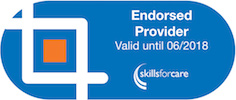Future Awards regulated level 3 qualification in the management of Anaphylaxis
The purpose of their regulated Future Awards Qualification Level 3 Award in the Immediate Management of Anaphylaxis is to provide the learner with the skills, knowledge and understanding required to recognise and manage a casualty experiencing an acute anaphylaxis episode.
This qualification will give learners the opportunity to:
- Know how to recognise a casualty with anaphylaxis.
- Be able to manage a casualty who is breathing normally
- Be able to manage an unresponsive casualty who is not breathing normally
- Be able to manage a casualty with anaphylaxis.
There are no formal qualification entry requirements that a learner must have completed before taking this qualification and no requirement for learners to have prior skills, knowledge or understanding.
This course is available as a 100% classroom course. or a blended course using our video online training.
The content of this and all our courses has been independently certified as conforming to universally accepted Continuous Professional Development (CPD) guidelines and come with a Certified CPD Statement as well as a ProTrainings Certificate and for online courses an Evidence Based Learning statement.
This course gives learners the opportunity to gain a formally recognised regulated qualification. If you require funding, a regulated qualification is often required. Phone us and we can advise if needed. If you choose our course leading to a regulated qualification, there are additional assessment criteria to be undertaken with an instructor and a small extra certification charge.
| Regulated Qualification Details |
|---|
| Course Title: |
FAQ Level 3 Level 3 Award in the Immediate Management of Anaphylaxis (RQF) |
| QAN: |
601/4245/5 |
| Level: |
3 |
| Credit Value: |
1 |
| TQT: |
10 |
| The Register of Regulated Qualifications |
- Teachers
- Nurses
- Care workers
- Social workers
- Sports coaches
Learning Outcomes
1 Know how to recognise a casualty with anaphylaxis.
- 1.1 Describe anaphylaxis
- 1.2 Identify triggers for anaphylaxis
- 1.3 Describe life-threatening problems associated with the: • Airway • Breathing • Circulation • Disability (neurological status) • Exposure (Skin and mucosal changes)
- 1.4 Explain the need for an early call for help
- 1.5 Explain the treatment for anaphylaxis: • Removal of trigger • Auto-injector
- 1.6 Identify key features of adrenaline-auto injectors.
2 Be able to manage a casualty who is breathing normally.
- 2.1 Conduct a scene survey
- 2.2 Conduct an initial assessment using the ABCDE approach: • Airway • Breathing • Circulation • Disability • Exposure
- 2.3 Position the casualty presenting with: • Difficulty in breathing • Life-threatening circulation problems • Unconsciousness
3 Be able to manage an unresponsive casualty who is not breathing normally.
- 3.1 Recognise the need to commence Cardio Pulmonary Resuscitation
- 3.2 Demonstrate Cardio Pulmonary Resuscitation using adult or child manikin
4 Be able to manage a casualty with anaphylaxis.
- 4.1 Recognise the need to use an autoinjector
- 4.2 Prepare medication for administration during anaphylaxis treatment
- 4.3 Demonstrate the safe use of an adrenaline auto-injector using training device
- 4.4 Safely dispose of sharps according to agreed ways of working
- 4.5 Handover the casualty to a medical professional.







